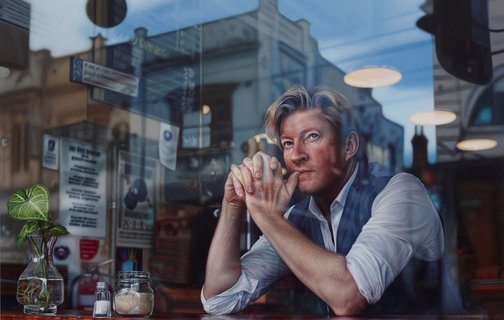The Risk of more megapixel, pin sharp fast lenses and pixel peeping is producing boring photo, putting pressure on storage, taking longer to process and not forgetting more expensive gear to start.
It is the same as for Photorealistic paintings, the work is technically outstanding but the Images soon become boring. Often very boring. Frequently the brilliant technical specs get overlook because their is nothing for the viewer to work out and keep their interest. In the art world there is a nice example in last year Archibald prize. The technically well executed and large Hyperrealist painting of David Wenham by Tessa MacKay was pretty much overlooked by the judges. Yet it was popular with the public and won the packing room prize, which is judged by the gallery staff who receive, unpack and hang the entries. In this case the artist has looked at a strong composition of building over the road seen through the glass window and painted reflections of the interior. So there is a fair bit to see but once you notice the detail becomes tedious and it back to being boring
Getting back to photographs, whilst other “purist” photobuffs, you tube watchers and owners of the latest and greatest cameras will enthusiatically discuss bokeh and edge to edge crispness. The average public viewer will look instead at the subject perhaps to composition and/or colour and perhaps interesting patterns or textures then they will move on. Capturing their gaze to look a little longer which usually depend on print size and viewing distance. Further weather you can interest them at that scale
Viewing distance and print size.
I have written about this previously, and that is a good summary. The issue here is you must concern yourself with the viewers eyesight media for display and type of illumination, print sharpness usually isn’t a real consideration. There is also a lot written about this on the internet and a lot of it is only partially truthful and/or bias. The chart on the left show the relationship between common sizes (in Inches BTW) and the megapixel count of the image and assumes that you will want to print at 300 ppi (pixels per inch). Each coloured rectangle then has the number of megapixels required for a given size. You will probably be surprised how few megapixels are required for common sizes. So what happens to all the extra detail capture on a full frame/high megapixel camera? Well they just get averaged together and that detail disappears
Capturing the Viewers attention
On instagram/Facebook were images are displayed on small screens and this is potentially the place you can show your work to the potentially greatest number of people. Both Instagram and Facebook now use algorithmic methods to display your post, and they may very well limit the display to 20 cases and stop there if no one interacts with you post/picture. Thus if you are looking to become famous for your photographs you need to be already famous (ie have a lot of friends that follow and interact with you). The images displayed are tiny (and thus not detailed) and are normally held close. Unfortunately the viewer also has the ability to scroll through the images quickly. You might only have half to a couple of seconds to get them to stop and take a long look. This favours bold composition, strong colours and tones. #hashtags and clever titles.
Small prints. Portfolios and Photobook, larger Ipads and Tablets have and arms length or less view distance and because they can be picked up and handled they are likely to get the closest scrutiny. Thus they do need the required level of detail (eg 8 megatpixel for 10” by 8”). They should be designed the allow the viewer an extended period to inspect (this might include captions and perhaps a short paragraph of so to provide context.) They are likely to be the very best way to get anyone interested in your photography, having the massive advantage of social media sites on small screens in that they are something tangible and physical.
On a wall (could be in a gallery or your home). This is the reason usually give for large sensors and High megapixel counts, it in theory allows for big prints (often gigantic) but this is probably the most challenging way to promote your work. Firstly large prints can be expensive to create and frame and it is likely to have the smallest number of viewers. Further the potential buyer is likely to consider these larger image as a décor items not art (ie does it make the couch)?
Friday, March 06, 2020
The Risks of more Megapixel, pin sharp fast Lenses and Pixel-peeping
Subscribe to:
Post Comments (Atom)

No comments:
Post a Comment